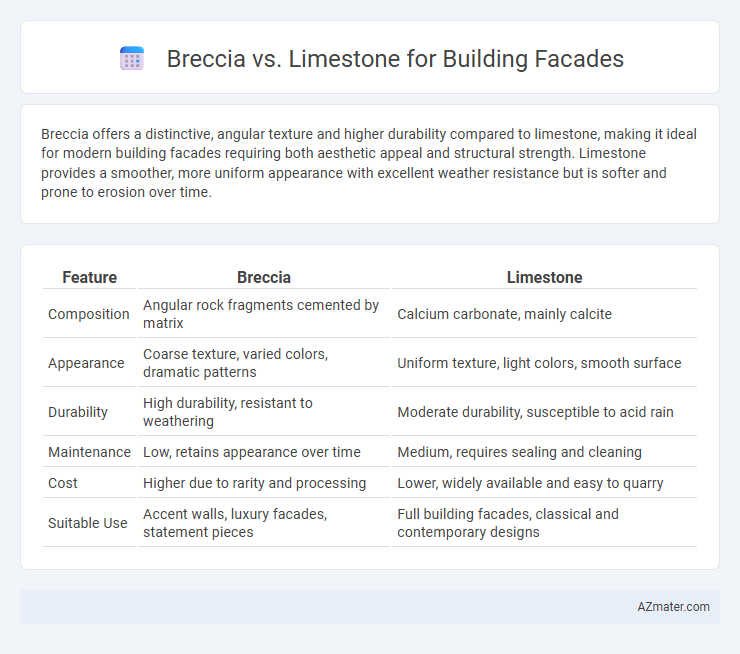Breccia offers a distinctive, angular texture and higher durability compared to limestone, making it ideal for modern building facades requiring both aesthetic appeal and structural strength. Limestone provides a smoother, more uniform appearance with excellent weather resistance but is softer and prone to erosion over time.
Table of Comparison
| Feature | Breccia | Limestone |
|---|---|---|
| Composition | Angular rock fragments cemented by matrix | Calcium carbonate, mainly calcite |
| Appearance | Coarse texture, varied colors, dramatic patterns | Uniform texture, light colors, smooth surface |
| Durability | High durability, resistant to weathering | Moderate durability, susceptible to acid rain |
| Maintenance | Low, retains appearance over time | Medium, requires sealing and cleaning |
| Cost | Higher due to rarity and processing | Lower, widely available and easy to quarry |
| Suitable Use | Accent walls, luxury facades, statement pieces | Full building facades, classical and contemporary designs |
Introduction to Breccia and Limestone
Breccia, characterized by its angular fragments cemented together, offers a unique textured aesthetic and robust structural integrity for building facades. Limestone, a sedimentary rock primarily composed of calcite, provides a classic, smooth appearance with excellent workability and weather resistance. Both materials are valued in architecture for their distinct visual appeal and durability, making them popular choices in facade design and construction.
Geological Formation and Composition
Breccia is a clastic sedimentary rock composed of angular fragments cemented together, typically formed from rapid deposition in tectonically active areas, giving it a highly heterogeneous texture ideal for unique architectural facades. Limestone is primarily composed of calcium carbonate, formed from accumulated marine organisms' skeletal fragments in warm, shallow seas, resulting in a more uniform and durable material suitable for classic building facades. The contrasting geological formation processes and compositions influence their structural properties, weathering patterns, and aesthetic appeal in facade applications.
Distinct Visual Characteristics
Breccia features angular, multi-colored fragments embedded in a contrasting matrix, creating a dramatic, textured appearance ideal for bold building facades. Limestone offers a more uniform, subtle aesthetic with fine grains and consistent coloring, providing timeless elegance and smooth surfaces. The choice between Breccia and Limestone hinges on desired visual impact, with Breccia emphasizing rugged complexity and Limestone showcasing classic refinement.
Mechanical Strength and Durability
Breccia exhibits superior mechanical strength compared to limestone due to its angular fragments and dense composition, making it more resistant to impact and heavy loads on building facades. Limestone, while aesthetically appealing and easier to carve, tends to be softer and more porous, leading to increased vulnerability to weathering and erosion over time. The high durability of breccia ensures longer-lasting structural integrity in facades exposed to harsh environmental conditions.
Weather Resistance and Longevity
Breccia offers superior weather resistance for building facades due to its composition of angular rock fragments cemented in a finer matrix, providing enhanced durability against freeze-thaw cycles and moisture penetration. Limestone, while aesthetically pleasing and easier to work with, is more susceptible to acid rain and chemical erosion, which can compromise its longevity in harsh environmental conditions. Choosing Breccia ensures a longer-lasting facade with reduced maintenance demands, making it ideal for climates experiencing extreme weather variations.
Maintenance Requirements
Breccia requires more frequent sealing to prevent moisture penetration and staining due to its porous structure, whereas limestone demands regular cleaning to avoid surface erosion caused by acid rain and pollutants. Both materials benefit from periodic inspections to identify cracks and chips early, but limestone is more susceptible to biological growth such as algae or moss, necessitating targeted treatments. Maintenance costs for breccia tend to be higher over time, while limestone's smoother surface allows for easier routine upkeep.
Sustainability and Environmental Impact
Breccia and limestone differ significantly in sustainability and environmental impact when used for building facades. Breccia, often sourced from local quarries, typically requires less energy for extraction and processing, reducing its overall carbon footprint, while limestone, though abundant and durable, involves higher energy consumption and CO2 emissions during quarrying and calcination. Both materials offer natural durability and thermal mass, but Breccia's unique composition can contribute to reduced waste and enhanced recyclability in eco-friendly construction.
Cost Comparison
Breccia typically commands a higher price than limestone due to its rarity and unique variegated appearance, making it a premium choice for building facades. Limestone offers more budget-friendly options as it is more abundant and easier to quarry and process, resulting in lower transportation and installation costs. The overall cost comparison favors limestone for large-scale projects requiring economical facade solutions, while breccia suits luxury designs where aesthetic value justifies the expense.
Popular Architectural Applications
Breccia offers a dynamic, textured appearance popular in modern architectural facades, with its angular fragments providing a bold, rustic aesthetic contrasted by its durability and weather resistance. Limestone remains a classic choice for building exteriors, prized for its smooth, uniform surface, ease of carving, and timeless elegance seen in historic landmarks and contemporary designs alike. Both materials are favored in architectural applications for their unique aesthetic qualities and structural properties, with breccia lending a more dramatic, rugged look and limestone offering softness and versatility in facade design.
Choosing the Right Stone for Your Facade
Breccia and limestone each offer distinct aesthetic and structural qualities for building facades, with breccia known for its bold, fragmented appearance and superior durability, making it ideal for high-traffic or weather-exposed areas. Limestone provides a softer, more uniform texture with excellent workability and thermal insulation but requires careful sealing to prevent erosion from moisture and pollutants. Selecting the right stone depends on factors such as climate, desired facade style, maintenance requirements, and structural load considerations to ensure longevity and visual appeal.

Infographic: Breccia vs Limestone for Building Facade
 azmater.com
azmater.com